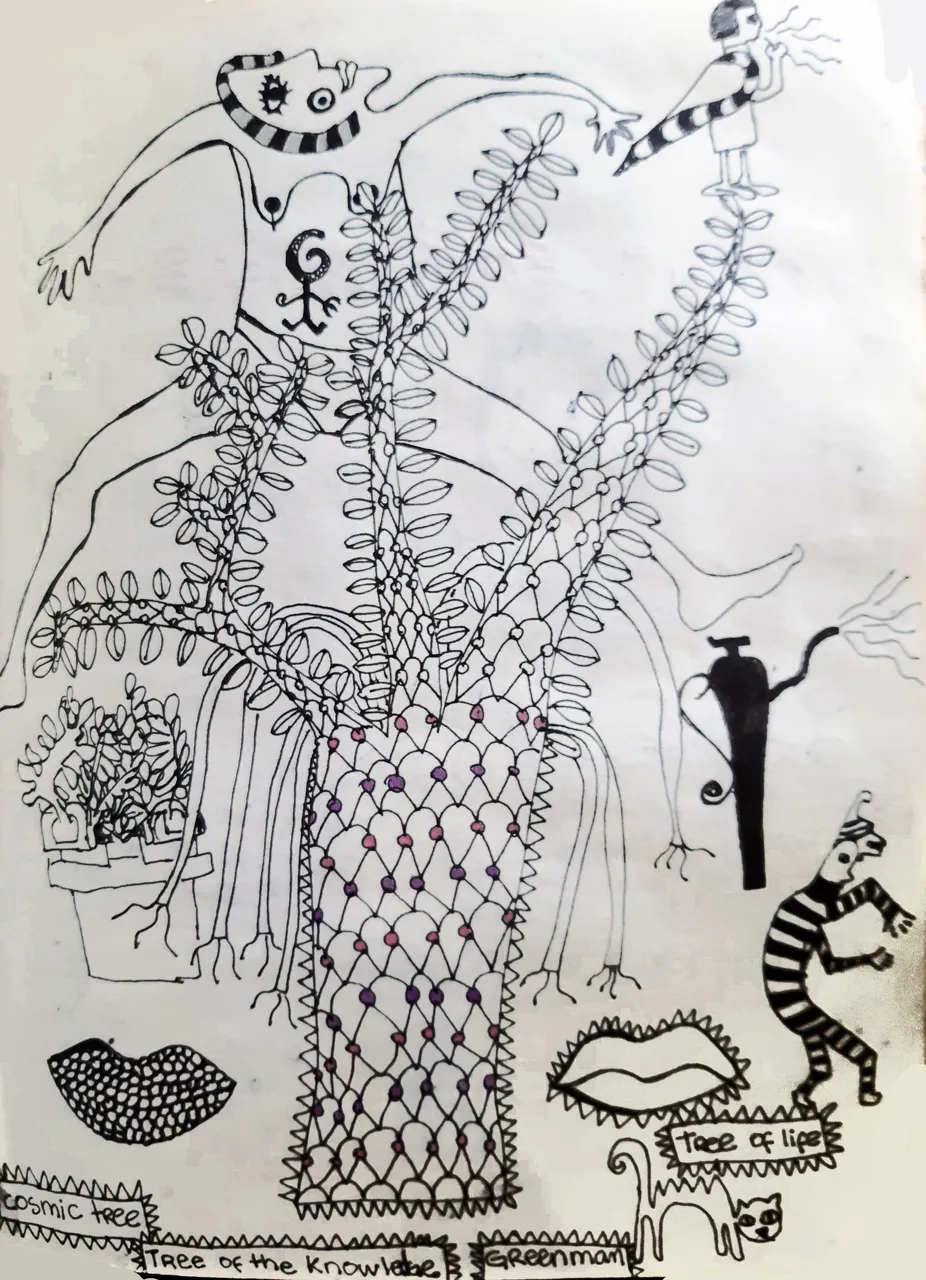
Saludos, queridos Hivers!! Para mi es un verdadero gusto poder participar en este hermoso reto de honrar a la dadora de vida, la Pachamama. Por eso quiero compartir esta esta dicha con amigos muy creativos para que se unan a esta hermosa iniciativa y son @gaboamc2393, @gislandpoetic y @soldierofdreams

Un día el sigiloso sol la estuvo espiando por entre la altas ramas de los árboles y decidió que quién sintiera ese fervor por cuidar a las plantas, debía tener algo especial y le concedió el don de llamar a la lluvia.
Ocseneba era descendiente de la tribu caribe, esa aguerrida tribu que habitaba las montañas frente a la costa que lleva el nombre de su tribu, en la zona que hoy llamamos Los Caracas, que es el otro nombre con el que se les conoce. Fue concebida con tanto amor, que los nativos caribes debieron inventar una palabra solo para referirse a ella, así Osceneba no solo era su nombre, también significa amor en esa lengua, nombre que llevaba con orgullo.
Ocseneba se dedicaba a proteger a los seres que veneraban al sol, y volaban a su encuentro tomando el color verde de la esperanza. Ella los protegía de bichos e insectos que solo buscaban su néctar para dejarlo podrir y alimentar a una reina ambiciosa del color de las plantas y las flores, las amantes del sol. El sol también les tenía cariño y respeto a estas plantas, porque ellas lo levantaban cada mañana.
A través de estas especies, Ocseneba conoció la importancia del sol, en una época donde la luna no existía, y no existían, tampoco, las mareas. Ella le prestaba especial cuidado al árbol del conocimiento, un árbol cósmico que guardaba todo el conocimiento del universo en su salvia, y mientras transcurría el siglo de las sequías, repartía a gotas, ese conocimiento desde la costa hasta los altos tepuyes donde se escondía su hermano el árbol de la vida. Así, entre ellos fueron creando la vida en esa zona de pobladores rojos como la arcilla. Nacieron, de éste modo, los cocos y los aguacates, las papas y los ajíes.

Ocseneba, conocedora de los prodigios de las frutas en los cuerpos rojos de los habitantes del caribe, decidió protegerlos de los males del fuego y otros predadores. Se volvió entusiasta del riego, y decidió adorar al sol junto a las plantas.
El sol, al ver como estas eran atendidas, comenzó a prestar atención a las acciones de estar mujer, la veía traer el agua de ríos y quebradas, y disfrutar de los olores y compañía de las plantas. El sol encontró en ella una aliada para la vida y el verde frescor de la naturaleza.
Un día, el sol estaba cansado, por los continuos viajes por el cosmos, y quiso reposar un poco. Fue cuando se dio cuenta que necesitaba más que una aliada, fue entonces que bajó a conocerla, para hacerla su fiel compañera en hermoso acto de crear vida. Bajó a la tierra ataviado con una máscara de arcilla roja, para no asustarla. Lo que el sol no sabía es que ella también lo adoraba a él.
Al hablar, el dios del cielo, o Kaapu, le propuso que se convirtiera en su esposa y señoreara el cielo junto a él, ella no estuvo conforme, pues deseaba seguir mojando sus pies en las aguas de la tierra, oler el verde pasto que se mecía junto a ella, comer del hermoso árbol que llegaba hasta él. Fue entonces que el sol convocó a las llanuras del desierto y lo calentó hasta hacer de esa tierra el cristal que formaría a la luna en el cielo, se la ofreció de regalo nupcial, prometiendo que esta formación blanquecina la ayudaría en la tarea de la que era responsable Ocseneba en la tierra.
A cambio ella prometería visitarlo siempre y ayudar en el descanso de sus labores en el cielo. Así Ocseneba se unió al sol en matrimonio, y comenzó a regir los movimientos del agua y se crearon las mareas. La lluvia reemplazó las taparas que usaba para refrescar a las plantas y el mas puro verde brilló bajo el sol.
Por las noches ella subía para habitar la luna y acompañar al dios del cielo o Kaapu; Nunno como le decía el sol a Ocseneba se transformó en la espuma del agua que recorría los senderos, llenando de vida cristalina a los árboles, plantas y flores de la diosa tierra, o Pachamama. Juntos ofrecían vida y amor a los moradores de la tierra, regando de hermosos frutos sus laderas.


Greetings, dear Hivers! For me it is a real pleasure to participate in this beautiful challenge to honor the giver of life, the Pachamama. That's why I want to share this joy with very creative friends to join this beautiful initiative and they are @gaboamc2393, @gislandpoetic and @soldierofdreams.

Ocseneba never thought of being mythical, she even fled from any hint of popularity, but she was always invoked in droughts and for her it was impossible to ignore these requests.
One day the stealthy sun was spying on her through the high branches of the trees and decided that whoever felt that fervor to take care of the plants, must have something special and granted her the gift of calling the rain.
Ocseneba was a descendant of the Carib tribe, that hardy tribe that inhabited the mountains in front of the coast that bears the name of her tribe, in the area that today we call Los Caracas, which is the other name by which they are known. She was conceived with so much love, that the native Caribs had to invent a word just to refer to her, so Osceneba was not only her name, it also means love in that language, a name she carried with pride.
Ocseneba was dedicated to protect the beings that worshiped the sun, and flew to meet it taking the green color of hope. She protected them from bugs and insects that only sought her nectar to let it rot and feed an ambitious queen of the color of plants and flowers, the sun lovers. The sun also had affection and respect for these plants, because they raised it every morning.
Through these species, Ocseneba learned the importance of the sun, at a time when the moon did not exist, nor did the tides. She paid special attention to the tree of knowledge, a cosmic tree that kept all the knowledge of the universe in its sage, and while the century of droughts went by, she distributed that knowledge by drops from the coast to the high tepuis where her brother, the tree of life, was hiding. Thus, between them they were creating life in that area of settlers as red as clay. Thus, coconuts and avocados, potatoes and chili peppers were born.

Ocseneba, knowing the wonders of fruits on the red bodies of the Caribbean inhabitants, decided to protect them from the evils of fire and other predators. She became enthusiastic about watering, and decided to worship the sun along with the plants.
The sun, seeing how they were cared for, began to pay attention to the actions of this woman, watching her bring water from rivers and streams, and enjoying the smells and company of the plants. The sun found in her an ally for life and the green freshness of nature.
One day, the sun was tired from its continuous travels through the cosmos, and wanted to rest for a while. It was when he realized that he needed more than an ally, it was then that he came down to meet her, to make her his faithful companion in the beautiful act of creating life. He went down to earth wearing a red clay mask, so as not to frighten her. What the sun did not know was that she also worshiped him.
When speaking, the sky god, or Kaapu, proposed that she become his wife and rule the sky with him, she did not agree, because she wanted to continue to dip her feet in the waters of the earth, to smell the green grass that swayed beside her, to eat from the beautiful tree that reached up to him. It was then that the sun summoned the desert plains and heated it until it made of that earth the crystal that would form the moon in the sky, offered it to her as a nuptial gift, promising that this whitish formation would help her in the task for which Ocseneba was responsible on earth.
In return she would promise to visit him always and help in resting from her labors in heaven. Thus Ocseneba joined the sun in marriage, and began to rule the movements of the water and the tides were created. The rain replaced the taparas she used to cool the plants and the purest green shone under the sun.
At night she went up to inhabit the moon and accompany the sky god or Kaapu; Nunno as the sun called Ocseneba became the foam of the water that ran along the paths, filling the trees, plants and flowers of the earth goddess, or Pachamama, with crystalline life. Together they offered life and love to the dwellers of the earth, watering its slopes with beautiful fruits.

El contenido aquí presentado es de mi autoría.
Las fotografías fueron tomadas con mi teléfono.
La imagen de portada fue editada en Illustrator con una de mis fotos.
Los separadores y banner fueron hechos por mi en Illustrator
The content presented here is my own.
The photographs were taken with my phone.
The cover image was edited in Illustrator with one of my photos.
The separators and banner were made by me in Illustrator.

Tu lectura es un gran honor para mi
Your reading is a great honor for me
Follow me



